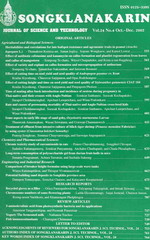ThaiScience
ThaiScience
SONGKLANAKARIN JOURNAL OF SCIENCE & TECHNOLOGY
Volume 42, No. 05, Month SEPTEMBER, Year 2020, Pages 1098 - 1105
Seismic anisotropy of the upper mantle beneath thailand tectonic setting constrained by shear-wave splitting analysis
Wisawet Wongwai , Passakorn Pananont , Eric Sandvol and Kevin Furlong
Abstract Download PDF
The tectonic setting of the lithosphere and upper mantle underneath Thailand varies and changes substantially over short distances. We have mapped these variations using shear wave splitting (SWS) analysis. We have determined the shear wave splitting fast polarization azimuth (Φ) and delay time (δt) using the grid search method with the assumption of a flat, single-layer upper-mantle anisotropy. The data set was constructed using 117 teleseismic earthquakes with magnitudes greater than 5.8, and epicentral distances between 80 and 180 degrees that occurred between 2009 and 2013, using earthquake information from USGS Comprehensive Earthquake Catalog. This resulted in 425 observations with clear P-wave arrivals, SKS, and SKKS phases. Our results show that 70% of the stations (15 of 22 stations) on the Shan-Thai terrane have N-S fast orientations and an average delay time of 0.7±0.2 seconds. 100% of the stations (14 stations) located on the Indochina terrane have dominantly E-W fast orientations and an average delay time of 0.8±0.2 seconds. This point supports the interpretation that on a lithospheric scale, Thailand consists of two major terranes
Keywords
Thailand, tectonic setting, shear-wave splittingSONGKLANAKARIN JOURNAL OF SCIENCE & TECHNOLOGY
Published by : Prince of Songkla University
Contributions welcome at : http://rdo.psu.ac.th
